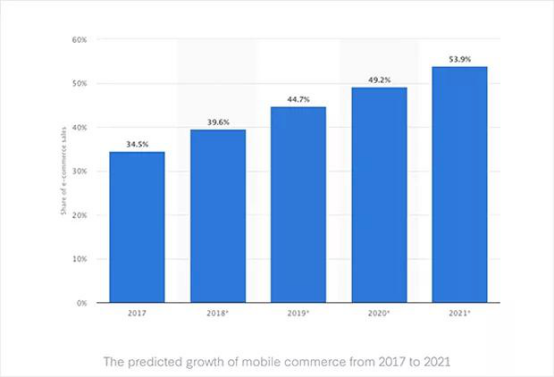According to the data released by the National Bureau of statistics, China's online retail sales in 2019 amounted to 106,324 billion yuan, an increase of 16.5% over the previous year.So, what will be the global online shopping trend in 2020?
Understanding the data behind global online shopping helps cross-border sellers to develop strategic plans for their e-commerce business.
Statistics of global online shopping trend in 2020
1、 Statistics of overall online shopping data
Let's start with the overall online shopping statistics and let you know how large the industry is.
Online shopping has developed so rapidly that the global online shopping market is expected to reach US $4 trillion by 2,020.In the United States alone, there are expected to be 300 million online shoppers by 2,023.That's 91% of the population in the United States!
So far, 69% of the U.S. population is online shopping, and 25% of the U.S. population is online shopping at least once a month.Most of them (59%) purchased clothing, and 47% purchased the first item on the company.
According to Invesp, the countries with higher e-commerce per capita income are the United States (US $1,804), the United Kingdom (US $1,629), Sweden (US $1,446), France (US $1,228), Germany (US $1,064), Japan (US $968), Spain (US $849), China (US $626), Russia (US $396) and Brazil (US $350).


As of 2,018, the penetration rate of global digital Buyers was 47.3%.If we look at the statistics by gender, it is not surprising that there is a difference in the proportion of male and female buyers - 72% for women and 68% for men.

The main difference between men and women is the products they purchase.Men usually buy products such as furniture and computers, while women usually buy groceries and clothes.
2、 E-commerce store statistics
In the near future, the mobile conversion rate of small retailers may be 30% higher than that of large retailers.
Moreover, if you are not involved in e-commerce, this is a good time to start.In 2019, it is estimated that there will be 1.92 billion digital buyers, with e-commerce sales accounting for 14.1% of global retail sales.“
By 2,023, e-commerce retail sales are expected to rise from 14.1% to 22%.
However, it is important to ensure that your e-commerce website is optimized for the user experience.
It is also important to include full details in the product pages.88% of consumers believe that detailed product pages are essential for purchasing decisions.
3、 Mobile shopping statistics
According to the data, 77% of digital window shoppers will be shopping on impulse, and 70% will buy on the device within the first hour of seeing the product.
Mobile shopping is rapidly catching up with PC shopping.Mobile shopping allows people to shop anywhere, up to 49% of them only use mobile phones, which means that 49% of the traffic is from mobile users.Therefore, it is important to optimize your mobile website.


Compared with physical shopping and PC shopping, the growth of mobile shopping is significant.By 2,021, mobile devices are expected to dominate online sales, accounting for 54% of total sales.
Not only do people use their smartphones to shop online, 65% of them also check the price comparison when shopping in physical stores.
4、 Online shopping and technical statistics
Some popular trends in 2019 will continue to be popular in 2020.Chat robots are an example.Over the past 12 months, 60% of consumers have used chat robots to find out.For millennials, chat robots are the preferred support channel.
The main reason chat robots are so popular is that response speed is always important when people want answers.
Did you use a chat robot?It is estimated that by 2,020, 80% of enterprises will have chat robots on their websites.
Another popular trend is voice assistant, which completes 20% of the searches on Google.Moreover, it is predicted that the search volume of voice assistant will increase to 50% by 2,020.
By 2,020, the number of smart speakers will reach 21 million 400 thousand.


5、 Data for black Friday and cyber Monday
In 2018, 174 million U.S. people spent an average of $335 per person shopping at this festival.
93% of the largest consumers (millennials aged 24 -35) plan to shop on holidays, spending an average of $419.52 per person.


Most of the shopping took place online (58 million) rather than offline (51 million).50% of people stay at home and use their devices to browse the web.On online Monday, 53% of all purchases were made on mobile devices.
According to BigCommerce, the more successful practices of e-commerce stores in 2018 are:
● sold through Facebook or Instagram
● e-mail marketing before Thanksgiving
● leverage on the sales of Amazon
● content and business integration and strategy
● inventory preparation
● mobile and desktop user experience
● red online marketing and social media engagement
wps25.png
6、 The future of online shopping Statistics (generation Z)
Although the older members of "generation Z" are just coming of age, their spending power cannot be underestimated.Marketing staff need to understand the unique needs and consumption habits of this generation to maintain relevance.
It is predicted that the generation born after 1,998 will have a purchasing power of USD44 billion.So far, 93% of parents have said that their generation Z children will affect family spending.In a few years, this generation will dominate 40% of the consumer market.
95% of people in generation Z own their own smart phones and spend nearly 10 hours or more on them every day.As a result, they are 2 times more likely to shop on mobile devices than Millennials.They spend more time on Instagram and YouTube videos.
Surprisingly, Facebook usage among teenagers has dropped significantly, from 71% in 2014 to 51% in 2018.Instagram is the preferred platform for brands.Regardless of which platform to use, 85% of generation Z will learn about new products through social media.